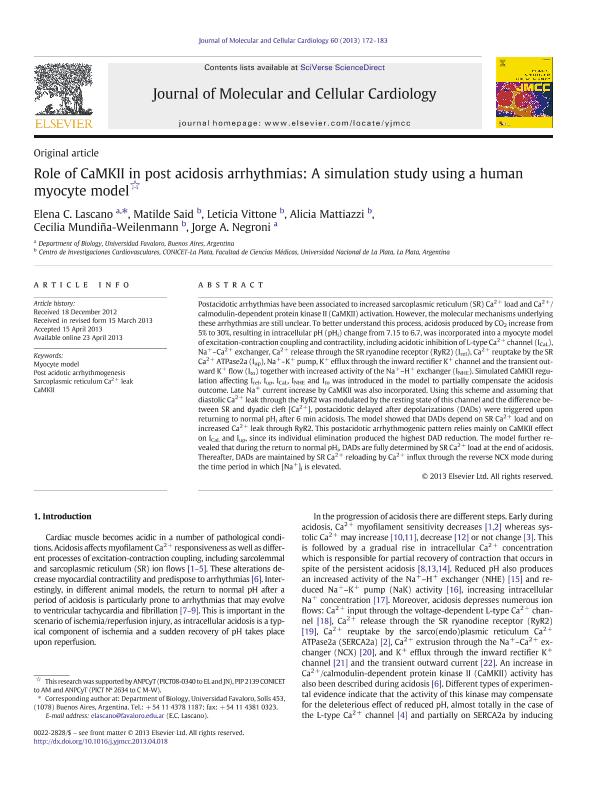Mostrar el registro sencillo del ítem
dc.contributor.author
Lascano, Elena Catalina

dc.contributor.author
Said, Maria Matilde

dc.contributor.author
Vittone, Leticia Beatriz

dc.contributor.author
Mattiazzi, Ramona Alicia

dc.contributor.author
Mundiña, Cecilia Beatriz

dc.contributor.author
Negroni, Jorge Antonio

dc.date.available
2017-01-25T20:37:10Z
dc.date.issued
2013-07
dc.identifier.citation
Lascano, Elena Catalina; Said, Maria Matilde; Vittone, Leticia Beatriz; Mattiazzi, Ramona Alicia; Mundiña, Cecilia Beatriz; et al.; Role of CaMKII in post acidosis arrhythmias: A simulation study using a human myocyte model; Academic Press Ltd - Elsevier Science Ltd; Journal of Molecular and Cellular Cardiology; 60; 1; 7-2013; 172-183
dc.identifier.issn
0022-2828
dc.identifier.uri
http://hdl.handle.net/11336/11954
dc.description.abstract
Postacidotic arrhythmias have been associated to increased sarcoplasmic reticulum (SR) Ca2 + load and Ca2 +/calmodulin-dependent protein kinase II (CaMKII) activation. However, the molecular mechanisms underlying these arrhythmias are still unclear. To better understand this process, acidosis produced by CO2 increase from 5% to 30%, resulting in intracellular pH (pHi) change from 7.15 to 6.7, was incorporated into a myocyte model of excitation-contraction coupling and contractility, including acidotic inhibition of L-type Ca2 + channel (ICaL), Na+–Ca2 + exchanger, Ca2 + release through the SR ryanodine receptor (RyR2) (Irel), Ca2 + reuptake by the SR Ca2 + ATPase2a (Iup), Na+–K+ pump, K+ efflux through the inward rectifier K+ channel and the transient outward K+ flow (Ito) together with increased activity of the Na+–H+ exchanger (INHE). Simulated CaMKII regulation affecting Irel, Iup, ICaL, INHE and Ito was introduced in the model to partially compensate the acidosis outcome. Late Na+ current increase by CaMKII was also incorporated. Using this scheme and assuming that diastolic Ca2 + leak through the RyR2 was modulated by the resting state of this channel and the difference between SR and dyadic cleft [Ca2 +], postacidotic delayed after depolarizations (DADs) were triggered upon returning to normal pHi after 6 min acidosis. The model showed that DADs depend on SR Ca2 + load and on increased Ca2 + leak through RyR2. This postacidotic arrhythmogenic pattern relies mainly on CaMKII effect on ICaL and Iup, since its individual elimination produced the highest DAD reduction. The model further revealed that during the return to normal pHi, DADs are fully determined by SR Ca2 + load at the end of acidosis. Thereafter, DADs are maintained by SR Ca2 + reloading by Ca2 + influx through the reverse NCX mode during the time period in which [Na+]i is elevated.
dc.format
application/pdf
dc.language.iso
eng
dc.publisher
Academic Press Ltd - Elsevier Science Ltd

dc.rights
info:eu-repo/semantics/openAccess
dc.rights.uri
https://creativecommons.org/licenses/by-nc-sa/2.5/ar/
dc.subject
CAMKII
dc.subject
MYOCYTE MODEL
dc.subject
POST ACIDOTIC ARRHYTHMOGENESIS
dc.subject
SARCOPLASMIC RETICULUM CA2+ LEAK
dc.subject.classification
Fisiología

dc.subject.classification
Medicina Básica

dc.subject.classification
CIENCIAS MÉDICAS Y DE LA SALUD

dc.title
Role of CaMKII in post acidosis arrhythmias: A simulation study using a human myocyte model
dc.type
info:eu-repo/semantics/article
dc.type
info:ar-repo/semantics/artículo
dc.type
info:eu-repo/semantics/publishedVersion
dc.date.updated
2017-01-25T13:57:20Z
dc.journal.volume
60
dc.journal.number
1
dc.journal.pagination
172-183
dc.journal.pais
Estados Unidos

dc.description.fil
Fil: Lascano, Elena Catalina. Fundacion Favaloro; Argentina
dc.description.fil
Fil: Said, Maria Matilde. Consejo Nacional de Investigaciones Cientificas y Tecnicas. Centro Cientifico Tecnológico la Plata. Centro de Investigaciones Cardiovasculares "dr. Horacio Eugenio Cingolani"; Argentina. Universidad Nacional de la Plata. Facultad de Ciencias Médicas; Argentina
dc.description.fil
Fil: Vittone, Leticia Beatriz. Consejo Nacional de Investigaciones Cientificas y Tecnicas. Centro Cientifico Tecnológico la Plata. Centro de Investigaciones Cardiovasculares "dr. Horacio Eugenio Cingolani"; Argentina. Universidad Nacional de la Plata. Facultad de Ciencias Médicas; Argentina
dc.description.fil
Fil: Mattiazzi, Ramona Alicia. Consejo Nacional de Investigaciones Cientificas y Tecnicas. Centro Cientifico Tecnológico la Plata. Centro de Investigaciones Cardiovasculares "dr. Horacio Eugenio Cingolani"; Argentina. Universidad Nacional de la Plata. Facultad de Ciencias Médicas; Argentina
dc.description.fil
Fil: Mundiña, Cecilia Beatriz. Consejo Nacional de Investigaciones Cientificas y Tecnicas. Centro Cientifico Tecnológico la Plata. Centro de Investigaciones Cardiovasculares "dr. Horacio Eugenio Cingolani"; Argentina. Universidad Nacional de la Plata. Facultad de Ciencias Médicas; Argentina
dc.description.fil
Fil: Negroni, Jorge Antonio. Fundacion Favaloro; Argentina
dc.journal.title
Journal of Molecular and Cellular Cardiology

dc.relation.alternativeid
info:eu-repo/semantics/altIdentifier/doi/http://dx.doi.org/10.1016/j.yjmcc.2013.04.018
dc.relation.alternativeid
info:eu-repo/semantics/altIdentifier/url/http://www.sciencedirect.com/science/article/pii/S0022282813001491
Archivos asociados
